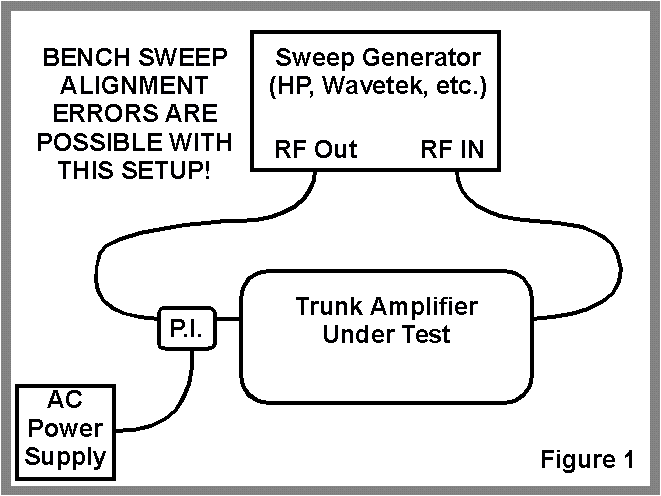| CATV
Bench Sweep Setup |
When a CATV bench sweep is used to align all RF
modules, any errors in the bench setup will translate to the system as an RF signature
which can become additive with the cascade length. It is therefore very desirable to
eliminate or minimize any sources of impedance mismatch on the test bench itself.
The sources of the mismatch are power inserters, splitters, couplers and a low-grade of
coaxial drop cable instead of a solid dielectric headend lash-up type cable. This
procedure will give the hints and kinks that are most commonly found in a test bench
setup.
The modern bench sweep has the ability to minimize the errors mentioned above by the use
of digital signal processing and internal calibration routines. This will reduce the
errors somewhat but is still open to some degree of error that can be removed by following
good setup practices of the mechanical portion of the bench that is described below.
These changes will improve the performance of any test bench with either old or new
test equipment. |
| Figure 1 shows the typical test bench which quite often has a
power inserter and regular drop cable as the key offending components. The
power inserter is necessary to power a line extender under test but is not required when
testing a trunk amplifier. Why, because the AC power source can be connected to any
feeder port on the trunk housing. Fuse only that feeder line and remove any trunk
power plug, fuses, etc. With the arrangement shown in figure 2, the power inserter
can be removed from the trunk test procedure and with its removal a device that has only a
16 dB return loss is eliminated from the circuit. |

|
| Next, the cable should be the solid dielectric cable
used in headend wiring. It will hold up better in the day-to-day handling that drop
cable will not survive. The return loss on the solid dielectric cable is also much
better than foam dielectric cables. The next thing that can be done is to put a 3
dB, type "F" inline pad on the input to the housing at the trunk input and trunk
output ports. The idea is to force the housing to see impedance match conditions
that are 26 dB return loss or better since this is what a reel of good trunk cable will
have as its return loss after it is installed on the strand. A good trunk cable
could easily have 30 dB return loss while it is still on the reel. Remember that we are providing the trunk amplifier housing with a test
environment that is similar to what it sees in the field -- it does not feed drop cable.
The 3 dB pads will be more effective on drop cable if you do not have a good solid
dielectric headend cable. Either way, all you need to do is compare the
peak-to-valley RF sweep response with and without the pads to see if you are benefiting
from their use. (Click here
for page 2.) |
